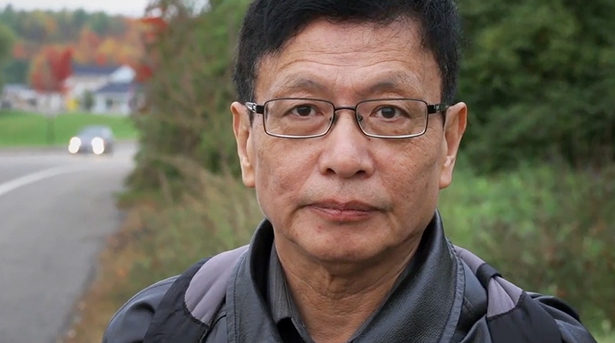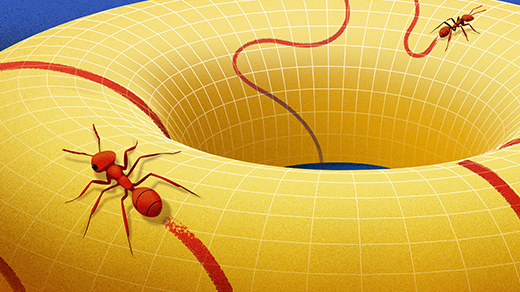After Prime Proof, an Unlikely Star Rises
As a boy in Shanghai, China, Yitang Zhang believed he would someday solve a great problem in mathematics. In 1964, at around the age of nine, he found a proof of the Pythagorean theorem, which describes the relationship between the lengths of the sides of any right triangle. He was 10 when he first learned about two famous number theory problems, Fermat’s last theorem and the Goldbach conjecture. While he was not yet aware of the centuries-old twin primes conjecture, he was already taken with prime numbers, often described as indivisible “atoms” that make up all other natural numbers.
But soon after, the anti-intellectual Cultural Revolution shuttered schools and sent him and his mother to the countryside to work in the fields. Because of his father’s troubles with the Communist Party, Zhang was also unable to attend high school. For 10 years, he worked as a laborer, reading books on math, history and other subjects when he could.
Not long after the revolution ended, Zhang, then 23, enrolled at Peking University and became one of China’s top math students. After completing his master’s at the age of 29, he was recruited by T. T. Moh to pursue a doctorate at Purdue University in Lafayette, Ind. But, promising though he was, after defending his dissertation in 1991 he could not find academic work as a mathematician.
In George Csicsery’s new documentary film Counting From Infinity, Zhang discusses his difficulties at Purdue and in the years that followed. He says his doctoral adviser never wrote recommendation letters for him. (Moh has written that Zhang did not ask for any.) Zhang admits that his shy, quiet demeanor didn’t help in building relationships or making himself known to the wider math community. During this initial job-hunting period, Zhang sometimes lived in his car, according to his friend Jacob Chi, music director of the Pueblo Symphony in Colorado. In 1992, Zhang began working at another friend’s Subway sandwich restaurant. For about seven years he worked odd jobs for various friends.
In 1999, at 44, Zhang caught a break. A mathematician friend helped him secure work as a math lecturer at the University of New Hampshire. When he wasn’t teaching his popular calculus classes, where students called him “Tom,” he thought about number theory. By 2009, he had turned his attention to the twin primes conjecture, which postulates that there are an infinite number of prime number pairs with a difference of two. Examples of twin prime pairs include 5 and 7, 11 and 13, and 17 and 19, but no one could prove that these pairs continue to exist all the way up the number line. In fact, no one could prove that there is any bounded prime gap at all, that primes don’t just grow infinitely far apart.
On April 17, 2013, the then-58-year-old Zhang submitted his proof of a bounded prime gap lower than 70 million to the Annals of Mathematics, one of the field’s most prestigious journals. Within a remarkably expeditious three weeks, the paper’s referees confirmed that Zhang, an unknown mathematician, had proved “a landmark theorem in the distribution of prime numbers.”
“Never heard of him. Absolutely never heard of him,” said Andrew Granville, a number theorist at the University of Montreal, in Counting From Infinity. When Granville heard about the result and the techniques that Zhang used, he recalled saying, “There’s no way that somebody I’ve never heard of has done this.”
Over the past two years, Zhang has traveled the world giving talks and has received the Ostrowski Prize, the Cole Prize, the Rolf Schock Prize, a MacArthur fellowship and the attention of this site, The New York Times, The New Yorker and many major media outlets. Zhang fielded numerous job offers and was promoted to full professor by the University of New Hampshire. This February, Quanta Magazine caught up with Zhang at the American Association for the Advancement of Science meeting in San Jose, Calif., where he presented recent advances in bounded prime gaps. An edited and condensed version of the interview follows.
QUANTA MAGAZINE: When and how did you first become aware that you were good at math?
YITANG ZHANG: When I was maybe the age of nine, maybe a little earlier, I was very interested in mathematics. I found the proof of Pythagoras’s theorem. No one told me anything about that.
You were growing up in China — Shanghai — and later you weren’t able to go to middle or high school.
Correct — because of the Cultural Revolution. At that time most of the people forgot about the science, the education. And instead, I was in the countryside just for the farm work. The revolution ended when I was 21. I went to Peking University when I was 23.
When you were not in school, how did you keep learning mathematics? Did you read books?
I read books. Actually, at that time I was also interested in lots of things. Not only math! Just reading every book I could get, like history and other topics.
Your background differs from that of most successful mathematicians. Even after you came to the U.S. and earned your doctorate, things didn’t go so smoothly. For many years, you were doing accounting work, working for friends, and not part of an academic setting.
Correct.
The math establishment didn’t realize that, “OK, this is somebody we should nurture and cultivate”?
This is correct. I was not lucky.
What can be done to better identify people like you?
Maybe it is more important for a person to make himself known to the public. But that was not so easy for me. My personality didn’t allow me to be very public, to be known by everyone, because maybe I’m too quiet.
There are other shy mathematicians who still seem to get the support they need.
These days, maybe it’s easier. Historically, Riemann, Abel and many other famous mathematicians did not have such easy lives. They were not lucky.
What is it about the problem of prime gaps and the distribution of primes that is so interesting to you?
Problems like this are so interesting to every mathematician, I think, because we try to answer the essential problems of the mystery of numbers.
When you decide which problem to tackle, what are the criteria? Does it have to have a certain level of difficulty?
Yes, a certain level of difficulty. And an importance to mathematics. It’s not that I say this is important, but that it is recognized as important by the mathematical community as a whole.
What is your approach to math beyond what you’ve said in other interviews — being patient and focused?
Do not easily say, “Oh, I really understand everything, so I have no problem.” You try to discover problems, to ask yourself the problems. Then you can find a correct direction to solve the problem.
Keep asking questions? And keep an open mind?
Yes. An open mind.
What questions are you asking right now?
Still in the field of number theory, I may not have only one problem to think about, but a couple of problems, like the distribution of the zeros of the zeta functions and the L-functions.
Are you still thinking about the twin primes conjecture — getting the gap down to two?
That’s not an easy problem. I didn’t find a certain way to do it.
What would get the public more interested in mathematics?
Many problems — in number theory in particular — are easy for the public to understand. Even with some of the deeper mathematical problems, it is not difficult to understand the problem itself. That could help people to become more interested in mathematics.
When you picture a mathematician, you’re probably not thinking of someone who’s onstage and getting awards. What is your image of a mathematician?
Intuition. Your feelings in math. What is that? It’s difficult to tell other people. That’s your personal stuff.
Some of the big awards in math, particularly the Fields Medal, are aimed at younger mathematicians. You were in your mid-50s when you worked on bounded prime gaps. You’re 60 now.
I don’t care so much about the age problem. I don’t think there is a big difference. I can still do whatever I like to do.
When you were younger and first starting to get interested in math, did you ever imagine that you would solve a major problem like this?
Yes. When I was very young, I imagined there would be a day that I would solve a major math problem. I’m self-confident.
So you weren’t necessarily surprised that you were able to solve the bounded prime gaps problem.
What surprised me was that my paper was recognized within three weeks. I hadn’t expected that.
You were very busy afterward, traveling to universities and responding to media requests. Are you looking forward to a period with fewer talks and interviews — just focusing on the next problem?
I’m tired! I wish I could save my time and not spend too much of it being a star.
What do you hope to achieve over the next couple of decades?
I hope I can solve a few more important problems just like this.
This article was reprinted on BusinessInsider.com.




